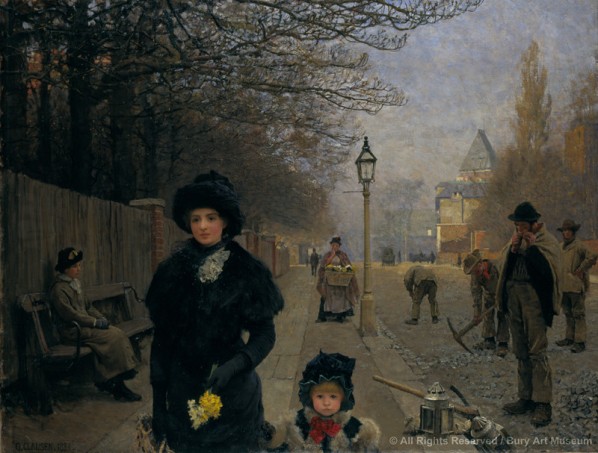
George Clause(1852-1944), Spring Morning Haverstock Hill, 1881; oil on canvas, 100x130.5cm, Burry Art Museum
Jointly organized by six domestic art museums including the Guangdong Museum of Art, Beijing World Art Museum, as well as three international institutes including Manchester Museums Union, International Touring Exhibitions Union, and Bury Art Museum, “Towards Modernity: Three Centuries of British Art” features 80 pieces of selected works of oil paintings, prints, watercolors, drawings and sculptures, from 18 museums and collections from the North West of England, where Manchester is at the center, participating artists including Turner, Constable, Henry Mole, Freud, Hogarth, Rossetti, etc.
Vividly depicting the history of art in the United Kingdom over 300 years, the exhibition is divided into six parts: “The British”, “Scene Observed”, “Natural Landscape”, “Tell a Story”, “Poetic Imagination” and “Modernism”, organized basically based on the history of British art, which can be summarized as having three main components. Firstly, from the break up between Henry VIII the King of England and the Pope, the establishment of the Church at the end of the medieval culture of the United Kingdom until the portrait with a secular means had become popular at the first half of the 18th century. Portraiture had been a unique style of British paintings for at least four centuries. It features the representatives of the British portraits, reflecting real British lives, as well as painting ideas and techniques of the artists. Secondly, it is undoubtedly the part featuring British landscape paintings. The development of the landscape painting was significant in the history of British art, and promoted the development process of the Western Modernist with the use of colors. Thirdly, it features from the Pre-Raphaelite initially advocating the true expression of their feelings and attitudes, until the artistic concepts of the modern schools such as Impressionism, Futuristic, and Abstract.
It includes mainstream as well avant-garde art, twenty-first century works as well as two-century old works, paintings as well as drawings, historical and religious subjects as well as portraiture and landscapes (two staples of British art), along with works depicting everyday life in a kind of artistic vernacular. It celebrates the individuality and eccentricity of British art as well as its sophistication and extraordinary levels of intrinsic skill.
British art
In Britain, because no specific academic system of artistic education has been established, painters have been at liberty to express their own particular creative bents without concern about the wider expectation of artistic taste.
Individuals who have sought to reform the practice of art in this country have usually done so from a position of artistic non-conformism or personal idiosyncrasy - for example of the drawings of William Blake, or the early experimental works of the Pre-Raphaelites, or the uniquely visionary canvases of Stanley Spencer. While the consequence may be an overall artistic development that is confusing and complicated to explain, it is nevertheless fabulously characterful and distinctive.
Translated by Chen Peihua and edited by Sue/CAFA ART INFO
About the exhibition
Duration: April 28 – June 14, 2013
Venue: Hall 1, 2, 3, 4, Guangdong Museum of Art




























